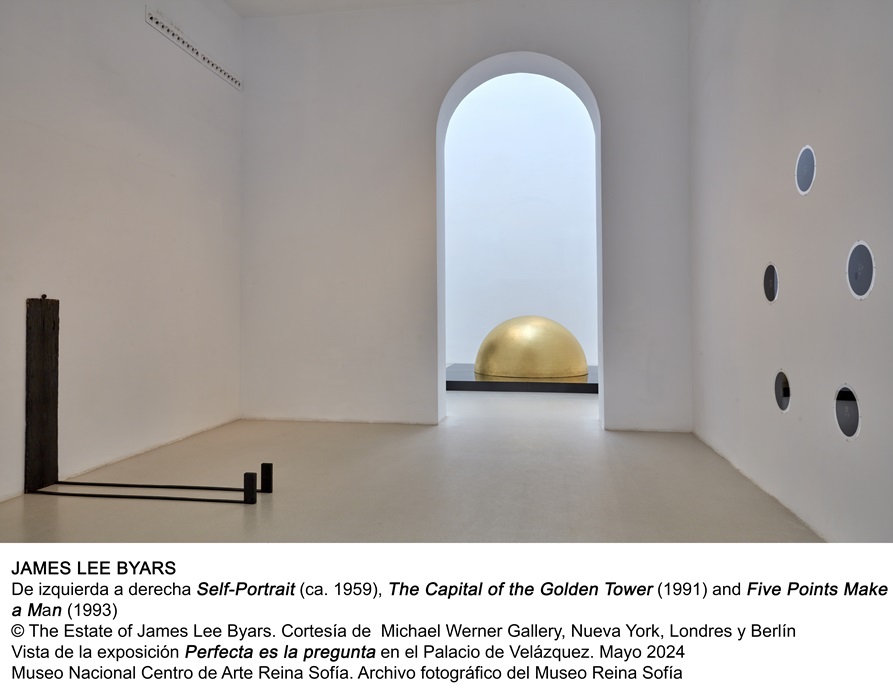Dedicated to one of the most enigmatic and striking figures in 20th century art, this exhibition brings together a significant group of works by James Lee Byars (Detroit, Michigan, 1932 – Cairo, 1997) that reveal his profound engagement with all that transcends the boundaries of logic. Byars’ visual and performative language, which moves between mysticism, spirituality and physicality, includes sculptures, installations, performances, drawings, the spoken word and the organisation of his own exhibitions, which are conceived as installations.
Image above: JAMES LEE BYARS Red Angel of Marseille, 1993 1000 red crystal balls FNAC 99316, AM 2000-DEP 37, Centre national des arts plastiques. Deposited at the Centre national d’art et de culture-Georges Pompidou, Paris. From the estate of James Lee Byars. Courtesy of Galerie Michael Werner, New York, London and Berlin. View of the exhibition ”Perfect is the Question” in the Palacio de Velázquez. May 2024 Museo Nacional Centro de Arte Reina Sofía. Photographic archive of the Museo Reina Sofía.

From the late 1950s and throughout the 1960s, the artist lived between Japan and the United States, and his fascination with Japanese culture strongly influenced his work. He also maintained close ties with Italy, particularly Venice, where he lived and worked in the 1980s. Throughout his career – and perhaps as an expression of his nomadic lifestyle – Byars combined in his works a deep understanding of Western art and philosophy with motifs, concepts and symbols from Eastern traditions and civilisations, such as elements of nō theatre and Zen Buddhism. The result was a unique vision of reality that paid special attention to physical and spiritual entities. In this sense, his artistic practice can be described as a mystical-aesthetic-existential reflection on notions of perfection and cyclicality, as well as on forms of representation and dematerialisation of the human figure.
In his investigations, Byars often sought to involve the audience through temporary actions or large-scale interventions in which he directly or indirectly posed various questions, while at other times he himself was responsible for activating them. Since his death, the latter aspect has raised questions about the visual and symbolic connections of a work in which the presence of the always charismatic Byars – his gestures, rituals and clothing – plays a central role.

When selecting the works for the exhibition, both the artist’s conceptual approach and the characteristics of the exhibition space, the Palacio de Velázquez, were taken into account, whose pronounced symmetry emphasises the monumentality and geometric simplicity of the works. Large-scale works are presented in precious and refined materials – such as marble, silk, gold leaf or glass – that harmoniously combine with minimal and archetypal geometries – such as prisms, spheres, columns – and propose a play of cross-references between form and content. An example of this is the Red Angel of Marseille (1993), located in the central area of the Palais: an installation in which a thousand red glass spheres arranged on the floor draw an anthropomorphic figure reduced to its essence, while the angelic connotation suggested by the title invites us to reflect on the links between the material and the divine. The totemic component is also present in The Golden Tower with Changing Tops (1982), a golden tower almost four metres high that reflects the artist’s search for the immutable. The cycles of life and the natural processes of change are represented by circles and spheres in The Door of Innocence (1986-1989), a golden marble sculpture in the form of a ring symbolising transition and transformation, and in The Tomb of James Lee Byars (1986), where the artist metaphorically encloses in a sandstone sphere the intangible concepts of spirituality and purity that contrast with this porous and layered material.
In addition to some early works such as Self-Portrait (1959), which illustrate the artist’s use of humour, the exhibition is complemented by a documentation of Byars’ performative activity, in particular the vanished installation La esfera de oro, which the artist presented in Granada in 1992 and for the inauguration of which he organised a performance in collaboration with the artist and poet Miguel Benlloch (Granada, 1954 – Seville, 2018). From the subsequent development of the work, Benlloch developed his installation O donde habite el olvido (2000), which can also be seen in the exhibition.

Taking into account the multiple allegorical and formal meanings of the material explored by the artist, the exhibition focuses on the main themes that run through his work, such as the search for perfection, doubt as an existential approach and the finitude of the human being, and invites the public to reflect on the alchemical potential of art to shape reality.
WHEN?
Exhibition dates:
Friday, 10 May to Sunday, 01 September 2024
Opening hours:
Open every day of the week
April – September from 10:00 – 22:00
WHERE?
Venue Parque del Retiro. Palacio de Velázquez and Palacio de Cristal.
P.º de Cuba, 4, Retiro, 28009 Madrid
COST?
Free entry






